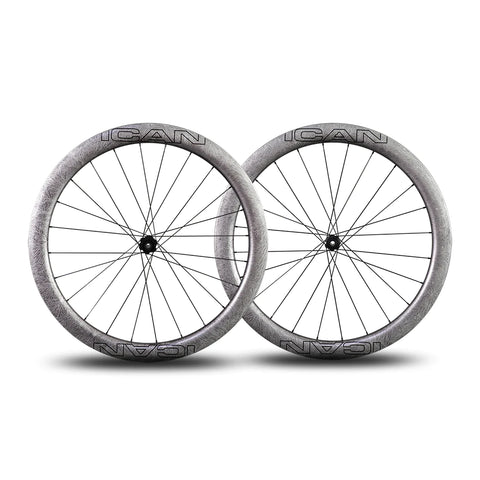What does it take to make a carbon wheelset?
Your bike wheels are one of the most important components on your bike; they’re the only contact point we have while riding. They are the best choice if you want to invest in a serious upgrade on your bike wheels. Even more so, the best way to better your riding experience is a carbon wheelset. Ask any professional rider; they ride on a beautiful set of carbon rims. But have you never asked yourself how a carbon wheel is made? In this article, we’d like to explain how we manufacture our wheels as easily as possible.
To most of us, carbon fibre manufacturing is a mystery, but with good reason. Companies invest a huge amount of resources and development into their propriety techniques. And we have done exactly that; we are always looking for ways to develop new processes and bring new and better products to you, our customers.
AERO 50 Disc DT240 EXP/350 Art Painting
What is carbon fibre?
Carbon fibre originated in the aerospace industry. It is made of loose fibres of carbon atoms suspended in resin to create a solid material. Carbon fibres are fibres about 5 to 10 micrometres in diameter and are composed mostly of carbon atoms.
Carbon fibre rims are made of carbon fibre and epoxy resin. When moulding a carbon fibre wheel, pieces of pre-preg carbon fibre are laid into moulds. Pre-preg is raw carbon fibre that is impregnated with an epoxy resin.
Carbon fibre has various advantages: high stiffness, low weight, high chemical resistance, high tensile strength, high temperature tolerance and low thermal expansion.
How is a carbon wheelset made?
The first step is designing the rim in our special 3D program. Here, we can already calculate the needed carbon fibre and the shapes we will need to lay up the carbon fibre.
To be precise, we source sheets of the highest quality carbon fibre, Torray T700 and T800 carbon fibre. This is also called pre-preg carbon. Pre-preg is raw carbon fibre impregnated with an epoxy resin. The second item we source is high-quality air bladders. We chose these air bladders because they produce much smoother rim walls. Every batch of raw materials we receive is submitted to a severe inspection with our DSC tester for any anomalies.
After the first inspection, we stored the carbon fibre in our refrigerator units at -5 °C. We need to do this to maintain the resin’s activity.
The next step is cutting the pre-preg to the desired lengths, shapes and angles (cut by our CAD-controlled device) and laying the carbon fibre within our custom-built moulds.
Precision is key in this stage of the process. Therefore, the layup is done by hand by experienced layup workers. All the wheelsets we offer have their layup schedule document that needs to be laid up meticulously.
The next stage will bring our wheelset to life: hot press moulding.
Carbon must be cured at a very defined temperature, which must be controlled permanently to give it its strength.
Our hydraulic moulding machines are specifically designed and PC-monitored for pressure, temperature and time to ensure we can always provide premium quality. Once heated, they’re cooled, and after demolding, we give the wheelset a first raw finish quality control.
In the following step, we need to remove the used air bladders. We use a unique process to extract the air bladders through the valve hole. Afterwards, the rim is sent to our hole-drilling machine. Here, we also use a computer-controlled CNC drill, which drills the spoke holes in a 4D direction.
We put our rims under second-quality control to ensure all holes are drilled correctly, and the rim surface remains intact. We also inspect the roundness and flatness of the wheels at this stage.
In the next phase, our rims are readied to visit our paint shop. Paint covers and protects the carbon. Our experienced staff members smoothen any small irregularity and give the rim surface a special treatment.
In the final manufacturing stages, the wheels really come to life after paint and decalcomania. They are laced up and trued by hand by our wheel builders to be given final quality control. Our wheels are torture-tested one last time: forward rigidity test, lateral rigidity test, impact test to meet all ISO standards, and more.
Once our wheelset is cleared from inspection, it is recorded in our database; each carbon rim is given a unique ID number. The only thing left to do is pack in our tailor-made foam bags and ship them out to your front door.
I hope we have enlightened you and that you learned something about our carbon wheel-making process without exposing too much of our magic.
Let us finally summarize the process of manufacturing carbon rim.
- Use carbon fibre material and air bladders incoming, and a special material air bladder which produces smoother rim walls;
- Applying a DSC tester to inspect physical properties;
- Storing in refrigerating equipment to maintain the activity of resin;
- Prepreg cutting, cutting to desired angles and shapes;
- Precise layup & pre-modelling, each rim carries its layup schedule documents, which are meticulously by experienced layup workers;
- Hot press moulding, PC hydraulic moulding machines with pressure temperature and time control;
- Raw finish rim quality control (QC-1);
- Remove the air bladders through the valve hole with a unique process;
- Drilling holes in 4D-direction using a controlled drilling machine;
- Quality control (QC-2), check and test;
- Smoothing, surface treated by experienced workers;
- Painting and decalcomania;
- Quality inspection (QC-3), 100% quality inspection and record in the database, each carbon rim is given a unique ID number;
- Packing: each carbon rim is packed in a tailor-made foam bag;
To see the video of manufacture process.

